


“histogram-probe” determines the update frequency of histograms. Press “Reset lists” to initialize data measuring and plotting. “update-method” parameter for min, max, and min-max methods (Gershenson and Pineda, 2009). “pass-allowed?” lets vehicles to go on top of each other. “min-intertrain-d” forces vehicles to stop when they are at this distance from a vehicle ahead. “max-speed” regulates the maximum speed of vehicles. Only a “buffer-capacity” number of passengers are allowed into the station entrance, the rest arrive to its right. “station-buffers?” creates buffers at station entrances. “max-margin” parameter for self-org method (Gershenson, 2011).

“max-station-wait-time” forces deprture of vehicles (only if all exiting passengers descended) after a maximum time at stations. “min-station-wait-time” restricts departure of vehicles only after they have spent a minimum time at stations. “train-capacity” sets the maximum number of passengers that can fit in a vehicle. self-org2 uses antipheromones to self-organize headways of alternating trains (with one train in between). default has no restrictions (always leads to unstable headways) min adaptively adjusts “min-station-wait-time” (Gershenson and Pineda, 2009) max adaptively adjusts “max-station-wait-time” (Gershenson and Pineda, 2009) min-max adaptively adjusts “min-station-wait-time” and “max-station-wait-time” self-org uses antipheromones to self-organize headways of neighboring trains (Gershenson, 2011).
NETLOGO WAIT MANUAL
“method” selects the headway regulation method: manual allows user to use parameters below. “homo-pass?” was changed or the intervals (shown at bottom left of stations) are not desired ones. Press “UpdateParam” to update the values of mean passenger intervals for stations, e.g. Otherwise, each station will choose from a Poisson distribution with mean “mean-passenger-interval” their own lambda. If “homo-pass?” is true, this will be equal for all stations. “mean-passenger-interval” indicates the average time (lambda of a Poisson distribution) between passenger arrivals at each station. “light-period” indicates the traffic lights cycle length. Traffic lights can be initialized with “init-lights” equidistant or with random positions. Stations can be initialized with “init-stations” equidistant or with random positions “#lights” indicates the number of traffic lights in the simulation. “#stations” indicates the number of stations in the simulation. Vehicles can be initialized with “init-trains” equidistant, with random positions, or aggregated. “#trains” indicates the number of vehicles in the simulation. Parameters below can be adjusted during a simulation run. Parameters above these buttons have to be set before the simulation starts. Press “Init” to reset the simulation with the same paramenters which were used in Setup. Press “Go” or “Step” to run the simulation. Press “Setup” to initialize the simulation with the parameters above the button.
NETLOGO WAIT FULL
Passengers board vehicles unless the vehicles are full or another restriction forces vehicles to leave the stations. At stations they stop until all passengers to descend exit. They move unless there is a vehicle (or a red light) in front of them.

Trains move along the cyclic tracks transporting passengers. It has been used to explore the equal headway instability phenomenon (Gershenson and Pineda, 2009) and to test different methods to promote equal headways. This is an abstract simulation of a public transportation system. Windows and Linux users may obtain the latest Java from
NETLOGO WAIT MAC OS X
Mac users must have Mac OS X 10.4 or higher. Java must be enabled in your browser settings. This page was automatically generated by NetLogo 5.0.3.


 0 kommentar(er)
0 kommentar(er)
